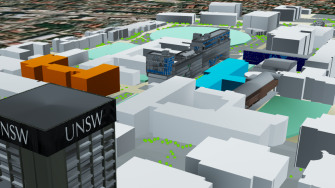
Project description
This project aimed to build on the work of RP2011 and showcase potential solutions to the challenges of modelling and managing precinct information. Recent advances in technology allow for a quick collection of 3D data and reconstruction of 3D realistic models. These come in addition to detailed 3D BIM models, which are becoming increasingly available as well. But the integration and maintenance of such 3D data remain problematic. Data and models are scattered in different file formats and layers and maintained by different departments and institutions. This complicates the update of data and the use and re-use of information. Despite international research efforts and developments, many issues related to structuring, semantic identification and management of 3D precinct information require further investigation. This project tried to address two of the most challenging issues: the effective integration of BIM and GIS for precinct modelling purposes, and 3D data integration and management. The developments were demonstrated on a relatively small but complex area, that is UNSW Kensington campus. UNSW Estate Management (EM) had been pursuing an innovative concept for 3D information management to support the concept of a “Smart Campus”. In discussions with EM, initial requirements had been identified.
Outcomes
This project investigated:
- a workflow for a 3D integration and reconstruction of the campus site from different data sources
- a concept for a 3D spatial data structuring. A prototype 3D workflow was investigated, aiming at the integration of 2D/3D existing data, point clouds (from different platforms), imagery/video (taken from drones or manually), BIM (as-designed and as-built), GIS and PIM. Some of the aspects to be investigated here are:
- time and effort to collect data
- resolution and accuracy
- software and file formats
- procedure for 3D reconstruction (indoor/outdoor)
- classification and semantic tagging.
Final presentation (pdf)
Data inventory - Report (pdf)
Data modelling - Report (pdf)
System visualisation - Report (pdf)
Project participants
The project was mainly conducted by researchers from UNSW School of Built Environment (GRID Lab and City Analytics), supported by the Estate Management department, the School of Photovoltaic and Renewable Energy Engineering (SPREE) and Civil Engineering. Standards Australia and the Centre for Urban Transitions (from Swinburne University of Technology) took part in this.
Acknowledgements
This research is funded by the CRC for Low Carbon Living Ltd supported by the Cooperative Research Centres program, an Australian Government initiative.
Contact person
Jack Barton (jack.barton@unsw.edu.au)
